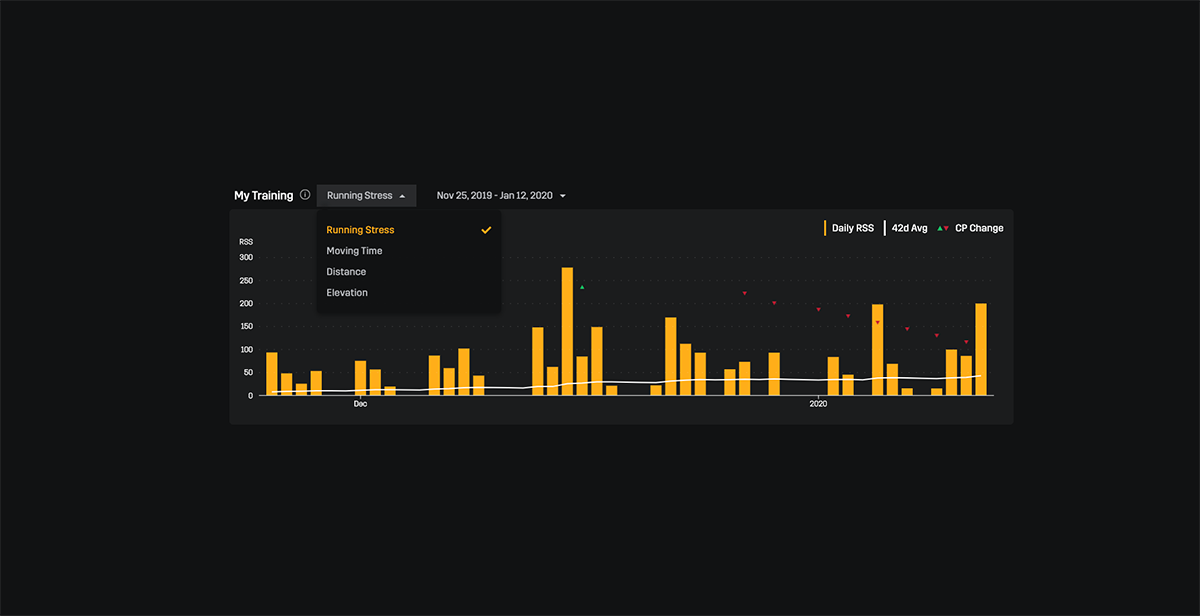Robust runners are built with the "My Training" chart

To run a faster endurance race, you need to become more robust to stress.
The best endurance runners can finely tune their robustness to stress at a very specific running duration and running intensity.
In the example of a marathoner, their body can handle a high intensity for the exact duration it takes them to complete a marathon.
If they either run for too long or at too high of an intensity, their body and will to run breaks down.
How do you become robust to stress?
There are only three ingredients you can drop into the mix:
- your running intensity
- your running duration
- your recovery
These ingredients must be added and balanced in a very structured and specific way.
Our new "My Training" chart in the new PowerCenter helps you monitor each of these three ingredients to methodically build up your robustness to stress.

This chart plots Running Stress, Moving Time, Distance, and Elevation.
For simplicity, we are only going to focus on Running Stress Score (RSS).
In a nutshell, RSS combines your running intensity and running duration into a single value of stress.
i.e. A 12 mile long run may be just as stressing on the body as an intense 6 mile interval session, whereas a 6 mile long run will be way easier than either of these runs and will produce a low RSS score.
(If you want more in-depth info on RSS, you can read our blog post here: https://blog.stryd.com/2017/01/28/running-stress-score/)Let's consider four scenarios where the "My Training" chart can guide you.
#1: Early in a training block
When you are early in a training block, you can ramp up your weekly stress by 5-10% every week.
The weekly training loads are fairly light when you are early in a training block. Your body can fully recover which means that you can immediately handle a slightly harder training week.
For example, a 300 RSS week followed by a 330 RSS week followed by a 360 RSS week would be a ~10% increase every week and would be near the maximum load you can expect to increase.
What should you look for in the "My Training" chart?
You want to stack your yellow stress bars slightly higher and higher every week
#2: Later in a training block
Eventually, the weekly RSS load becomes high. You cannot fully recover every week before the next week begins.
The wise thing to do is to complete a period of high load (maybe, a week or two of high load) and then follow it up with a week of lower training stress.
The week of lower load allows you to recover and prepare for the next week of higher stress.
As you progress, you should only try to ramp up your weekly running stress over the course of two to three week periods instead of every week.
What should you look for in the "My Training" chart?
You should still try to make your stress bars higher every few weeks, but you will need to drop them down at a minimum of every other week for proper recovery.
#3: Right before the race
In the weeks leading up to the race, your RSS scores should drastically drop as you begin to taper before your race.
This gives your body the best chance to recover from the period of highest stress stress.
This tapering period will let you build up to your best state of "robustness" to stress.
What should you look for in the "My Training" chart?
You should expect to see your yellow stress bars significantly drop down.
#4: Race optimization over the long term
You cannot continue to load more and more stress on forever.
Plus, there is no reason to.
A marathon, for example, can only be so stressful. You only need to optimize for that event and not for anything longer.
Instead of increasing training load, you need to begin increasing your Critical Power.
A higher Critical Power means that you can handle training at a higher and longer intensities.
Your training improves but your stress scores stay the same.
What should you look for in the "My Training" chart?
You want to look for the green arrow on your chart. The green arrow indicates that your Critical Power has increased and that you can handle higher training intensities.
The new "My Training" chart makes it easy to identify if you are "mixing" your intensity, duration, and recovery together in an optimal way.
You will never accidentally dump too much stress or too much recovery into your training.
This means you can methodically build a running body that is capable of handling the stress required to run the race of your dreams.
Do you want to get the most out of the "My Training" chart?
Here is what we want you to do:
1. Load up your "My Training" chart on your PowerCenter (https://www.stryd.com/powercenter/)
2. Try to identify each of these training patterns listed above
3. Reflect on if these training patterns proved advantageous to your training and how you can better structure your training in the future
